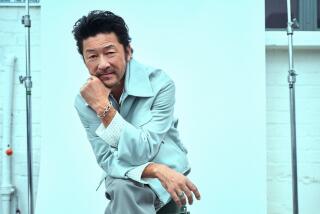Play it again, samurai, in new twists
- Share via
Every so often, just as the samurai film seems to be limping to its demise in Japan, a director comes along to give it a new shot of life. Five years ago, Nagisa Oshima gave the genre a homoerotic twist in “Gohatto” (“Taboo”), which generated renewed interest. Recently, two of Japan’s best-known filmmakers decided to take on the samurai genre for the first time.
Takeshi “Beat” Kitano, a flamboyant television and film celebrity, decided to remake the classic “Zatoichi,” featuring a blind masseur whose alter ego is a brilliant swordsman. The new incarnation, opening June 4, is dubbed “The Blind Swordsman: Zatoichi.” Yoji Yamada, a veteran director famous for the contemporary “Tora-san” series, decided to use several short stories as a springboard for his own spin on the genre in “The Twilight Samurai,” which opened last week. The samurai film is an equivalent of the western, a tried-and-true action genre which showcases the mettle of heroes and the wages of villainy, set comfortably in the past.
In Japan, period films have sometimes been thought a lesser genre, Yamada said on a visit to Los Angeles when “The Twilight Samurai” was a best foreign language film nominee at this year’s Oscars.
“It was Kurosawa who opened our eyes to what it could be,” he said. He was referring, of course, to the great director Akira Kurosawa and such classics as “Rashomon” (1950) and “The Seven Samurai” (1954), so internationally acclaimed it was remade by American director John Sturges into “The Magnificent Seven” (1960). Like Kurosawa, Yamada was interested in genre as a showcase for human drama, not for an invincible hero who is aching to flex his swordsmanship and cut down 30 villains with one blow (a convention Quentin Tarantino plays to the max, and at least partly for laughs, in “Kill Bill Vol. I.”)
A tall, courtly man with a shock of thick white hair, Yamada, 72, helped create one of the most beloved characters in postwar Japanese cinema, Tora-san, a well-meaning everyman who bumbled his way through life. Starting with the 1969 film “Tora-san, Our Lovable Tramp,” there were altogether 48 Tora-san films, all starring Atsumi Kiyoshi. Yamada directed all but two. The director points out that the other principals -- Tora-san’s family members, the local priest -- were also played by the same actors throughout. “It’s in the Guinness Book of Records,” he says. Busily churning out one to three Tora-san films a year for three decades, he has never made a period film. Several years ago he read a collection of short stories by Shuhei Fujisawa. These stories focused on lesser-ranked samurai and daily life in Edo-period Japan, and he saw his chance to make a film from them. In Japan, “The Twilight Samurai” was a box office success and won 12 Japanese Academy Awards, including best picture and best director, and Yamada is happily making another samurai film this year.
Freely weaving three of Fujisawa’s stories, Yamada created his own story about a low-ranking samurai with a self-esteem problem. Seibei Iguchi (Hiroyuki Sanada) is an impoverished widower raising two young daughters, so down at the heels he has holes in his tabi (two-toed socks) and moonlights making cricket cages out of bamboo sticks. Even when a pretty divorcee -- another unusual character for this genre -- takes a fancy to him, he has to turn her down for fear he cannot support another person. The climax comes when Iguchi has to capture a renegade samurai, leading to the confrontation of two reluctant warriors.
“I wanted to show how frightening it is to kill another person,” Yamada said. “I wanted to show how frightening it is to be killed.”
That idea came directly from Yamada’s own life. “I remember a story that my grandfather told me when I was a child,” he said. His grandfather, a member of the samurai class, had fought briefly in the civil war early in the Meiji era, and one day in the woods, he came face to face with an enemy. They drew their swords, they waved them about. “But they were both so frightened they wouldn’t get close to one another, and they shook their swords at each other for half an hour to an hour until they were exhausted.”
Yamada began laughing, miming his grandfather waving his long sword.
Finally, they clashed, briefly. His grandfather got a cut on the leg and sat out the rest of the war.
The director is, of course, not the first to depict reluctant warriors. Kurosawa’s classic “Rashomon” told the story of a robber’s attack on a samurai and his lady in the forest -- from four points of view. One version showed both samurai and robber fitfully flailing at each other, as eager to get away as to lay a blow on the enemy.
Throughout “Twilight,” Yamada paints a portrait of daily life of the period -- mealtime in Iguchi’s household, the children attending school, Iguchi going to work. On a typical day, Iguchi keeps accounts of his lord’s worldly goods. After hours, he’s expected to go out drinking with his colleagues. Could there be a reference to the modern “salaryman” in “Twilight”?
Yes, Yamada admitted it’s his nod to the worker who’s expected to be at the office from dawn to dusk, slaving for the corporation the way a samurai would have for his lord. However, his Iguchi goes home after work to spend time with his daughters -- another reason the others look down on him.
“It’s unusual for a samurai film -- he’s a family man -- but that’s what I wanted to portray,” Yamada said. “It’s the middle of the 19th century, a time of change, and someone like him would wonder, should I be loyal to the lord or my own family?” Similarly, the heroine, Tomoe (Rie Miyazawa), is “a new type of woman,” Yamada said. When her husband beats her, she leaves him and tries to choose her own next husband. “The Edo period lasted [nearly] 270 years,” Yamada said. “Women were treated so badly during this period.” And Tomoe is a sign that things were changing.
Filling big shoes
When confronted with remaking “Zatoichi,” about arguably the most beloved of Japanese action heroes, Kitano (“Sonatine,” “Hana-bi”) decided to update elements to his liking as well. “Zatoichi” debuted in 1963 and starred the late Shintaro Katsu, eventually spawning 25 sequels and a long-running television series with the same actor. Katsu played Zatoichi as a lovable and ingratiating character, a teddy-bear persona that hid a Robin Hood sense of justice and skill for lightning-quick swordplay. So ingrained was this image that Kitano never dreamed of playing him, except that strip club entrepreneur Chieko Saito, who had been a good friend of Katsu’s and held rights to the character, asked him to do so.
“I thought there was no way I was going to try and replace the image of Mr. Katsu’s trademark character,” Kitano said in an e-mail exchange. Unveiled at the Venice Film Festival last year, the film won a best director award for Kitano; on Thursday it is the closing film for the Los Angeles Asian Pacific Film and Video Festival. “But Madame Saito wouldn’t take no for an answer. Then it struck me that it could be interesting if I wrote and directed the movie myself with the idea of creating an entirely new Zatoichi.” Of course, he had to retain the main character of a blind masseur and secret “master swordsman and dice-gambling genius,” Kitano said. He also realized that the story would have to follow traditional lines.
“This being a Zatoichi movie, the main plot had to be Zatoichi on one side and bad guys on the other,” he said. “And it being a jidai-geki [period piece], there’s not much choice in side characters and their stories; a ronin struggling to return to his official position, orphaned sisters seeking revenge on their parents death ... [and] bad guys.”
In Kitano’s film, in which he also stars, Zatoichi comes to a new town and, just like in a western, pops into a bar (where they are drinking sake, not beer). Ostensibly he’s looking for work, but he’s also scoping out the local situation, which isn’t good. The townsfolk are caught in the crossfire of a gang war, and Zatoichi soon finds himself defending the locals, including two geisha sisters. Meanwhile, the local bad guys have hired another new arrival, a highly skilled ronin (Tadanobu Asano) who is trying to support himself and his sick wife.
Tweaking conventions
But while sticking to certain conventions, Kitano decided to have a little fun with the genre, which he found far less restrictive than imagined. Period costumes, with which people are familiar through silk-screen prints and textile artifacts, were used, but even this was tweaked with the help of fashion designer Yohji Yamamoto. “The most fascinating aspect of the genre is that you can basically fabricate everything,” Kitano says. “Every detail -- the looks of the characters, location, etc. -- is actually more fictitious than in a contemporary piece since everything is recreated.” And he could certainly play with the characters and the story -- the sisters are not what they seem to be, for example, and the motives of Zatoichi himself might be questioned.
In fact, the first surprise is his Zatoichi look -- he has short cropped blond hair, and no shaved forelocks or topknot like the other men of this period. For Kitano, “This would be the most obvious way to alert the audience Takeshi’s Zatoichi is totally different from Mr. Katsu’s -- and it’s also easier to distinguish him in sword fights.” Elsewhere, he’s suggested that his Zatoichi is Eurasian, thus doubly an outcast -- first for being blind, second for being foreign.
Audiences might also be jarred by sudden bursts of rhythmic beats and music that seem more modern than of the period. “The basic premise of the Zatoichi story was in itself preposterous enough for me to set out to make an all-out entertainment piece and to explore terrain I wouldn’t in my typical auteur pieces,” he says. Perhaps his greatest indulgence is the dance finale, a finger-snapping, exuberant chorus number that harks to Kitano’s beginnings in burlesque theater in Asakusa, Tokyo’s working-class entertainment district.
As he says, “For tradition to be relevant to our time, it needs a certain amount of rejuvenation.”
More to Read
Only good movies
Get the Indie Focus newsletter, Mark Olsen's weekly guide to the world of cinema.
You may occasionally receive promotional content from the Los Angeles Times.










